A Bloody Good Job: Carrie’s Makeup Maestro Jordan Samuel
Makeup department head Jordan Samuel had quite a task in front of him when he joined director Kimberly Peirce and the filmmaking team behind Carrie. "Truthfully, blood itself is one of the most difficult things for a makeup artist," Samuel says, "and the more there is the more difficult it is."
Now, add to the amount of blood Samuel would be working with in Carrie to the fact that he was a major part of making sure they could pull of recreating one of the most iconic scenes in horror film history, and you can imagine the pressure. Figuring out a way to film the moment that Carrie is doused with a bucket of pig’s blood is whole lot more difficult then simply dumping a bunch of red slop on Chloé Moretz Grace’s head. The splatter patterns must be exactly the same in every shot, for continuity purposes, so Samuel and his team had to figure out a way to engineer the most crucial shot in the movie so it could be fast, exact, and repeatable.
Far from a stranger to shoots that require a high degree of difficulty, Samuel’s worked on mega blockbusters like Pacific Rim, Total Recall and The Incredible Hulk, as well as garnering awards and nominations for his work on the musicals Hairspray, Chicago, and nabbing an Emmy for his work on 2011’s miniseries The Kennedys.
We spoke to Samuel about figuring out to film the worst prom scene in film history, working with horror master Guillermo Del Toro, and the nifty way you can make an actor look younger with some cord and tape.
So let’s talk about that famous Carrie moment at the prom. Can you walk us through the process of pulling that scene off?
There’s definitely a lot of components involved. I think from the makeup side of it, the trick is I wanted to make sure we could control and maintain the blood that landed on Chloé, and there’s not really any way to do that—it’s a random element, pouring a bucket of fake blood onto somebody from so high up.
But you pulled it off somehow…
We talked about the height that it was coming down, and there were many tests done with the viscosity of different materials. What we decided to do was completely step away from chance. We were going to control what she was going to look like after the bucket spilled on her, so that we were essentially working backwards and dictating what the after effect was going to be so there was nothing really left to chance. So given that, I sat down with Kimberly [Peirce] and the first thing to do was to decide the color of the blood.
At the risk of sounding naive, isn't it just red?
Bloods have a variety of different colors, depending upon the age of the blood, so on and so forth. So Kimberly chose the color and with that plan I went off with one of the illustrators in the art department, and we got a picture of Chloé and we started coming up with some designs together. One of the things I proposed to Kimberly, and something she really liked, was the idea was to play with the two sides of Carrie’s face. The left side was a little more sympathetic, and the blood drops are almost like tears around her eyes, it's her softer side. The right side was a lot more monstrous and demonic, almost like a skeletal design the way it splattered across the top of her face.
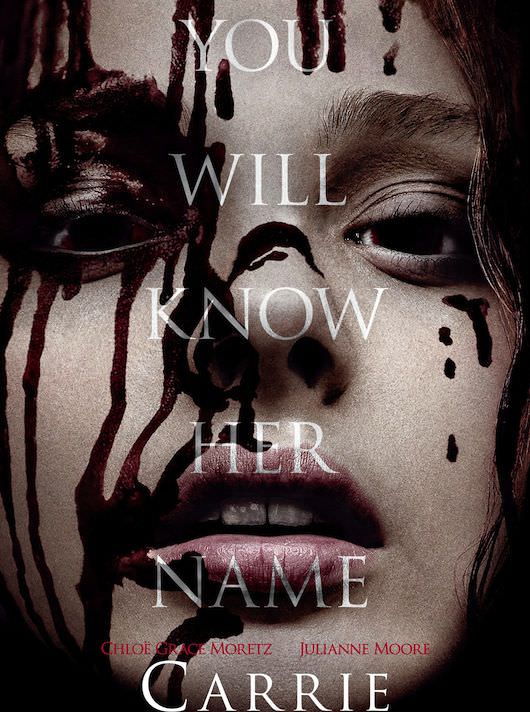
Kimberly really liked that design, so from that point on I went and had a cast done of Chloé that was finished in a white resin, and I hand painted in the blood tone that Kimberly had chosen. Then we created a three dimensional rendering of Chloé’s head cast on a computer. From that point on I had photographic and tattoo transfers made [by tattoo transfer guru Christien Tinsley] that went on Chloé everyday, so it was exactly the same every time it went on. And the blood was applied on top of that.
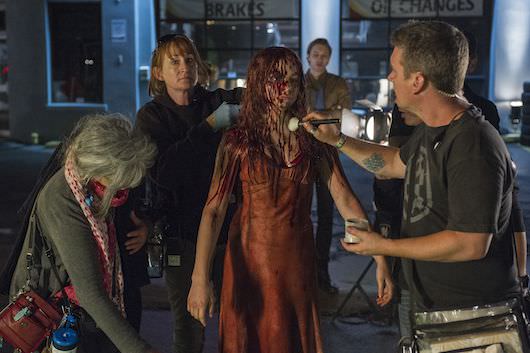
So you reverse engineered the scene?
Yeah. I think we only had to pour the bucket on Chloé two or three times because it had been perfected with a stand in and dummies. We basically cut from the blood flow in the movie to Chloe’s standing on stage with the pre-set blood on her, and that’s what the audience sees from that point on to the end of the movie. It was pretty tricky and pretty time consuming to do, but it worked out really well in the end. It was just a matter of changing the consistency of what was applied on top of those transfers, but the pattern was always the same, so there was nothing random about it, no chance of anything getting wiped away or going on in the wrong spot.
How was this different from the way it was done in the original?
Well, the effects guys shot video of all the tests that they were doing, they were sending them to Kimberly and I had a chance to see them and it was just completely random. Every time [the blood was poured] was different. The other thing that was happening, and if I remember correctly this happened in the original film, too, was when that huge amount of blood comes down and hits the top of her head it actually umbrellas out over her body. It ended up getting on her shoulders and landed on the floor in front of her, but actually very little of it would run down her face and down the front of her costume because of the physics of it, so it was a good way to control that, too.
What was the blood made out of it?
I’m pretty sure the effects guys made it out of the standard recipe of corn syrup and dye.
What other challenges did you face tackling this film?
We wanted to come up with characters who were iconic but would not necessarily look like carbon copies of the original movie. So there were a few changes that we made. I think one of the trickiest things to come up with was a look for Chloé, who’s such a beautiful girl. So the hair department played with hair colors, and we played with trying to tone down her look as much as possible. Hopefully we achieved that. What we did was we really dressed up the girls around her, without making it too terribly obvious. You know all the 'it' girls, the mean girls, they were all more made up and more fashion forward than anybody else, creating more of a contrast.
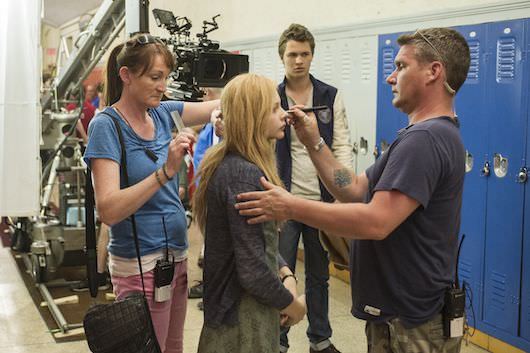
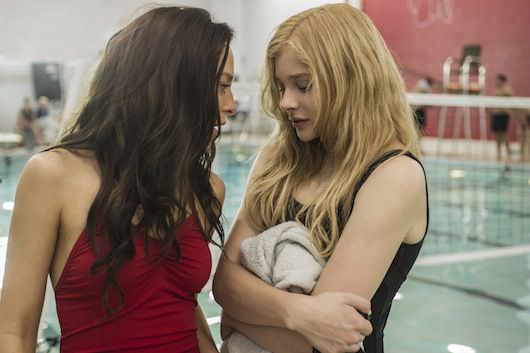
Were you one of those kids who was playing with ketchup as fake blood?
I have memories of being a little kid and sitting at the vanity in the family bathroom with latex and spirit gum and blood and playing in the mirror myself. I was always the first victim running around with my eye hanging out. It’s always been something that I’ve been into. Obviously there’s much more to makeup and running a department than the blood and effects, but Carrie was a great project because it covered the spectrum.
What was working on Pacfic Rim with Guillermo del Toro like?
That was probably the most fun I’ve had working on anything. Guillermo is like a big horror fanboy himself, and a monster movie fanboy, and a sci-fi fanboy, so it was great to work with him. I had some tattoos to do on people, and a little bit of breakdown in aging and casualty makeup to do. For the most part it was a feat of volume because we had so many background actors to process and look a certain way. I’m working with Guillermo right now on his pilot for The Strain.
How about working on Total Recall, another film that has really standout moments visually. The woman with three breasts, for example, is sort of iconic.
The version I worked had a little less prosthetic and animatronic element to it then it was in the original Schwarzenegger version. We had a few things to do, and yes, the three breast prostitute was there. That was an amazing makeup job done by a makeup artist the producers brought in who was just exclusively focused on that, and who knocked it right out of the park. For us makeup artists it was more of working on the environment and selling that sort of futuristic world that Recall existed in. Selling the breakdown of society in that post war environment, what people looked like health wise and economically, it was another movie about volume and massive crowd scenes.
I can imagine how one might make someone appear older in a film, but what kind of tricks do you have to make someone look younger?
There’s a lot of techniques that I can use there. A lot of it has to do with lighting. We can also do a lot of tricks with temporary face lifts.
Wait, what’s a temporary face lift?
It’s an old technique, actually, it’s been around for a long time. It involves using adhesive tabs and elastic or silk cording. You put these tabs on the side of the face in different strategic spots and the cord is run back around the actors head and tightened to create a temporary lift on the face. The tabs are generally hidden by wigs or hair pieces. You can’t tell that they’re there when they’re there, it’s a pretty cool effect.
Who’s used this in a film that stands out for you?
I can tell you somebody you used to see wearing them all the time, and it was interesting because sometimes she’d wear it and sometimes she wouldn’t wear them in her public life—Lucille Ball. She used to wear them the later years of her life. You’d see them in award shows, the Oscars and the like. Every once in a while she would have them, then she wouldn’t have them on, it was pretty obvious when they were there and when they weren’t there. They were quite popular for some time.
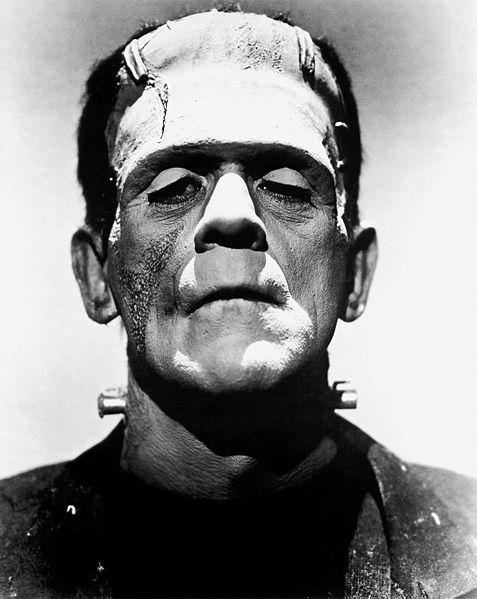
Who in the makeup artist world do you admire?
There’s a long list of people. I really admire Ve Neill’s work, I admire Christien Tinsley's work and his ingenuity, Dick Smith, obviously, I could keep going. I was just watching The Bride of Frankenstein and of course, Jack Pierce’s makeup on the monster, on Boris Karloff, I think it’s something that inspired everybody who’s in makeup at some part of their lives. There’s too many people to name, it’s such a creative career and it’s all about coming up with new ways to do something.
What kind of tricks do the actors have when they’re in the makeup chair for long stretches of time?
They can go over their lines, they can catch up on the news, they watch movies, it’s really depends on how long they’re in the chair. Some actors fall asleep in the chair, it really comes back to us making the experience as quick and as computer as possible.
Do you prefer when they fall asleep?
I think it depends on who’s in the chair (laughs).
Featured image: Make up artist Jordan Samuel (right) with hairdresser Cliona Furey (left) and Chloe Moretz on the set of Metro-Goldwyn-Mayer Pictures and Screen Gems' CARRIE.



